An article by guest writer Lam Chih Tsung. Refer to “About the Writer” at the end of the Post.
April 2013. An important year and month in my life. I have found a bunch of books, and with it new knowledge. I knew that my Great Great Grandfather, Lam Chiew San(蓝秋山), knelt down for three days in front of his mother, before she relented and allowed him to sail from South China to Nanyang (See Note 1 at end of post). I also knew that it was my Great Great Great Great Great Great Great Grandfather, Lam Yuan Zhang (蓝元騿), who first ventured from the ancient family village of Xiali (下坜) in Dabu (大埔) County, Guangdong, into the wilderness, thus founding my ancestral village of Gaodao (高道, also in Dabu) in the late 1600s.
All these I knew, and more. Instantly, I knew a multifold about the history of the Lam family, more than I had ever been told by family elders in Singapore, keen family historians though a few of them were. The amateur historian in me, so used to learning about distant peoples and places, was speechless by the treasure trove of information, all the more stunning because it was so close to home.
The ten volumes I found told the story of 800-900 years of Dabu Lams. This is the story of the ancestry of ten thousand modern day Lams, living in (or descended from) Dabu county, in the heart of Hakka country. ( Dabu is the ancestral home of a significant proportion of Singapore Hakkas, the most well known of whom would be Lee Kuan Yew and Lee Hsien Loong.)
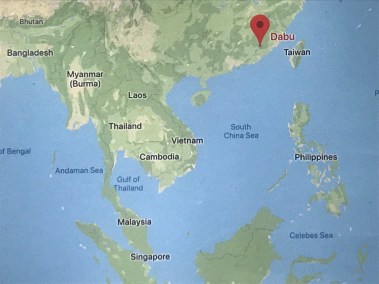
Dabu is on the northeastern edge of Guangdong Province, bordering Fujian province.
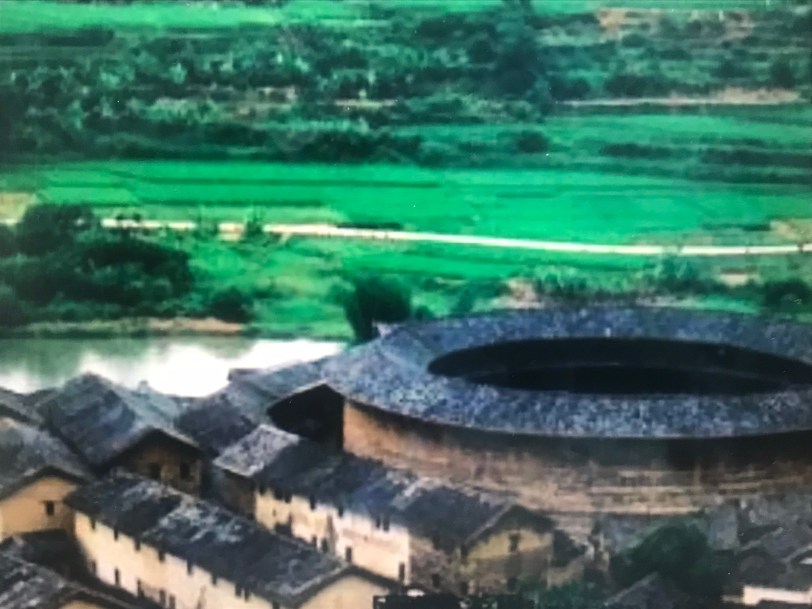
Pastoral scene in Dabu, with the iconic Hakka “Tulou”, a unique form of fortified communal housing, in the foreground.
My interest in genealogy was actually piqued by an ancestor on my mother’s side. I attended a talk by a Penang scholar who came to Singapore to speak, on prominent Penang merchants in the late 19th century. When I went up to talk to him after his lecture, I asked him, do you know of any prominent Oons? He knew of only one, and this man turned out to be my mum’s paternal grandfather Oon Boon Tan. Subsequent googling revealed Oon was a member of the Penang Chinese Chamber of Commerce, honorary Chairman of the Hokkien cemetery association, an unusual “scholar merchant” with a library of thousands of classical Chinese texts and rare Ming and Qing paintings. Qing dynasty officials visiting Penang, including the future tutor to the last emperor of China, would stop by to admire his collection and write classical poems to praise his gentlemanly ways. In the 1910s and 20s, he had one son who won a Queen’s Scholarship to Cambridge; another, my maternal grandfather, studied at the Massachusetts Institute of Technology and became the General Manager of Tan Kah Kee’s rubber factory, marrying his daughter in the process. A third rose to become Permanent Secretary Finance, the then de facto head of the Civil Service in 1960s Singapore. Not bad for a man who was born into poverty and never mastered English. My mum’s family had less interest in such matters (being practical, forward looking people unlike me) and didn’t speak of ancestry in family conversations. As a result, these discoveries about Oon Boon Tan were a total surprise to me.
In April 2013 (perhaps not a coincidence it being the year and month I turned 50), my interest thus piqued, I persuaded my parents to come with me on a trip to Fujian and Guangdong. The objective was to visit all four of my grandparents’ ancestral villages, both Hakka (Dad) and Hokkien (Mum). One ancestor, my mum’s maternal grandfather Tan Kah Kee was well known. However, what piqued my interest even more was to learn about my other ancestors, who had achievements to be proud of but were lesser known.
The most significant find was made when we were in Dabu, to track down my father’s paternal line. I visited the Lam Family Temple in Huliao (湖寮), county capital of Dabu. I wasn’t expecting much as our ancestral village was Gaodao, not Huliao. My Dad declined to come as he was tired.
I was thus pleasantly surprised to discover, shortly after arrival, that they had one item for sale. Ten volumes of the Dabu County Lam Clan Genealogical Tables (大埔县蓝氏族谱, “DLG” from hereon.). Price 600 RMB. (Descendents get a 50% discount.)
I looked at the ten volumes. They were like telephone directories. How do I go about finding say, my grandfather or great grandfather, I enquired?

The first volume of the 10th edition of the Dabu Lam Clan Genealogical Table……
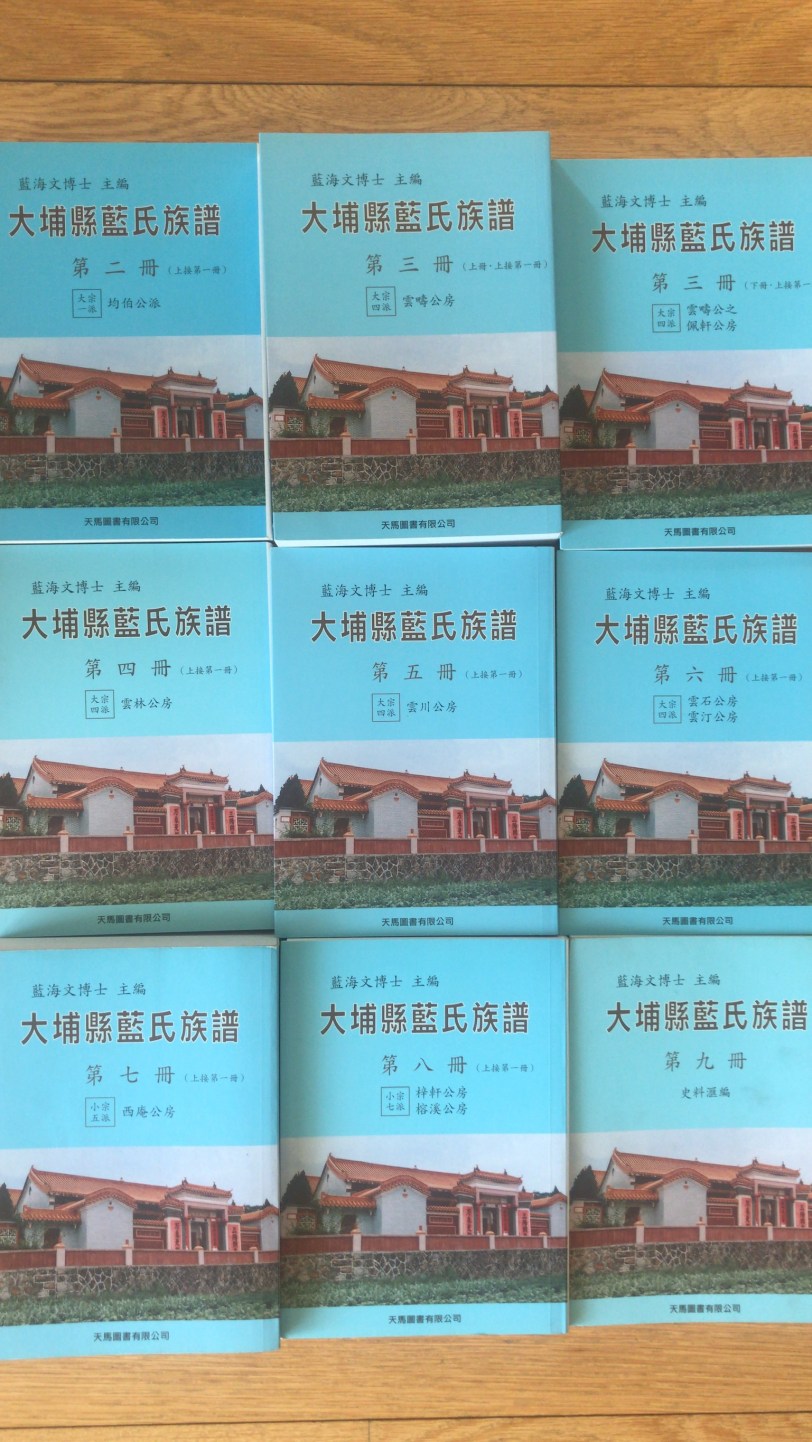
…..followed by the remaining nine…………
The temple custodian asked me a simple question : Which generation are you?
What do you mean “which” generation? This is when I learnt that every one of the ten thousand or so living male Lams listed in the ten volumes is descended from one single man, Lam Da Xing (蓝大兴), the first Lam to enter the county, from Fujian Province next door. (Only males are named, I apologise to my female readers. This is a document from an incredibly male chauvinist society, I unreservedly admit.) One’s generation number is therefore the number of generations you are removed from Lam Da Xing.
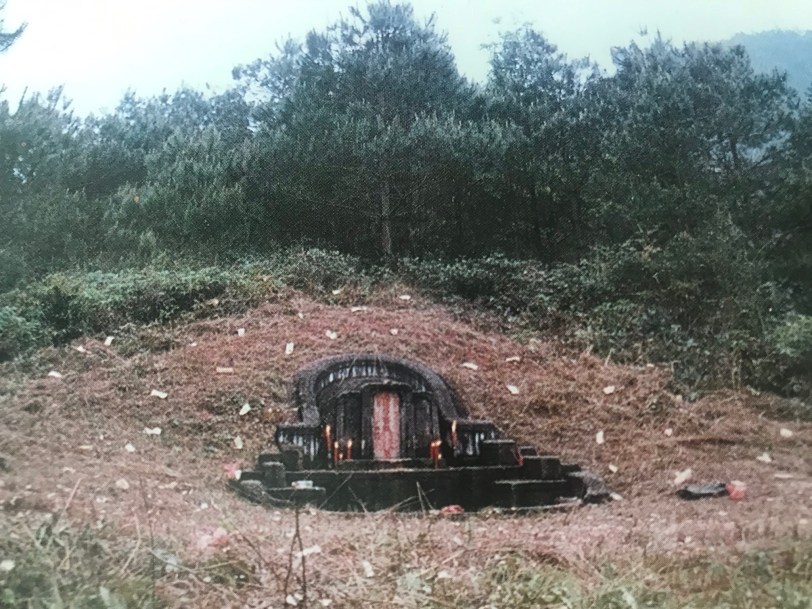
Tomb of Da Xing Gong, founding patriarch of the Dabu Lams. (From DLG)
Unable to answer this simple question, I scooped up my ten volumes and returned to the hotel. My first words to my dad was to echo the temple custodian’s question: which generation are you?
To my surprise, he didn’t need me to explain the question further. He replied, “I have been told but don’t remember exactly. I believe I am either generation 24 or 25.”
This was the only clue I had among the ten thousand names. How do I start– wade through the ten volumes, starting with volume one?
Fortunately, there was a good introduction by the Editor in Chief, Lam Hai Wen (蓝海文), in Volume One. He explained that what I was reading was the tenth edition of the DLG, which was updated and published by him in 1998. The first edition was written in 1542, during the Ming Dynasty, by thirteenth generation ancestors. Subsequently, at an average interval of 50 years or so, there was at least one fanatical soul willing to devote months, and later years, to compiling the genealogy of the burgeoning county clan.
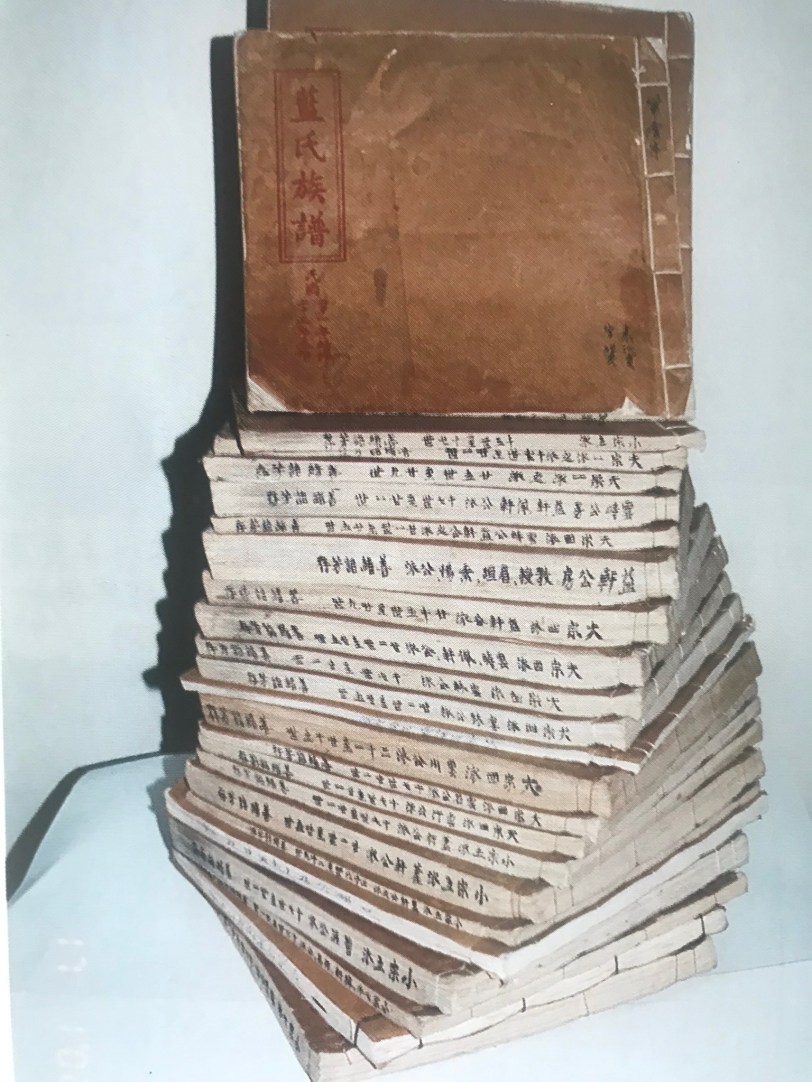
………And this was the ninth edition compiled in 1932. (From DLG)
Lam Hai Wen’s introduction made a few other interesting points. After the first six generations where there was only one son in each generation (Note 2), in the seventh generation, there were two sons, Gui Shan (贵山) the elder, and Xiu Shan(秀山) the younger. Those descended from Gui Shan are subsequently described as coming from the Senior Wing (大宗) and those whose ancestor is Xiu Shan are members of the Junior Wing (小宗). Gui Shan had four sons and Xiu Shan three. Their descendents are then described as coming from branches One (一派) to Seven (七派).
That was how the DLG was organised. By wings, then branches, and by sub branches and for branches which had numerous descendents, (you guessed it) sub sub branches.
In the table of contents, I noted that one sub branch had 37 generations listed (in 1998, that is). The two sub sub branches with the fewest generations had 28 and 29 generations listed, respectively.
Elementary, my dear Watson, I thought. If Dad is generation 24 or 25, that meant that I must be generation 25 or 26. Hence, it seemed very unlikely I could belong to the sub branch with 37 generations. Much more likely I belonged to one of the sub sub branches with the fewest generations.
I decided to start my search with the Shuang Hu Gong (Note 3) (双湖公) sub branch of the Xi An Gong(西庵公) sub branch of the Junior Wing Fifth Branch, which had 28 generations listed in 1998. I focused my searches on the three ancestors whose names I knew, Lam Chew San, Lam Sen Tong and Lam Joon Chong, respectively my Great Great, Great and Grandfather. They should range between generation 21 to 24. So these were the generations in the sub sub branch I searched.
No luck.
I decided to move on to the next generationally shortest sub sub branch. The Bi Ya Gong (碧涯公) sub branch of the Xi An Gong(西庵公) sub branch of the Junior Wing Fifth Branch, which had 29 generations listed.
Two hours after commencing my searches, I struck gold.
允藏。
My Grandfather’s name, Yun Cang in Hanyu Pinyin, Joon Chong on his Singapore IC (Hakka pronunciation). Listed under Generation 24. My dad remembered correctly. He was generation 25. I am therefore generation 26.
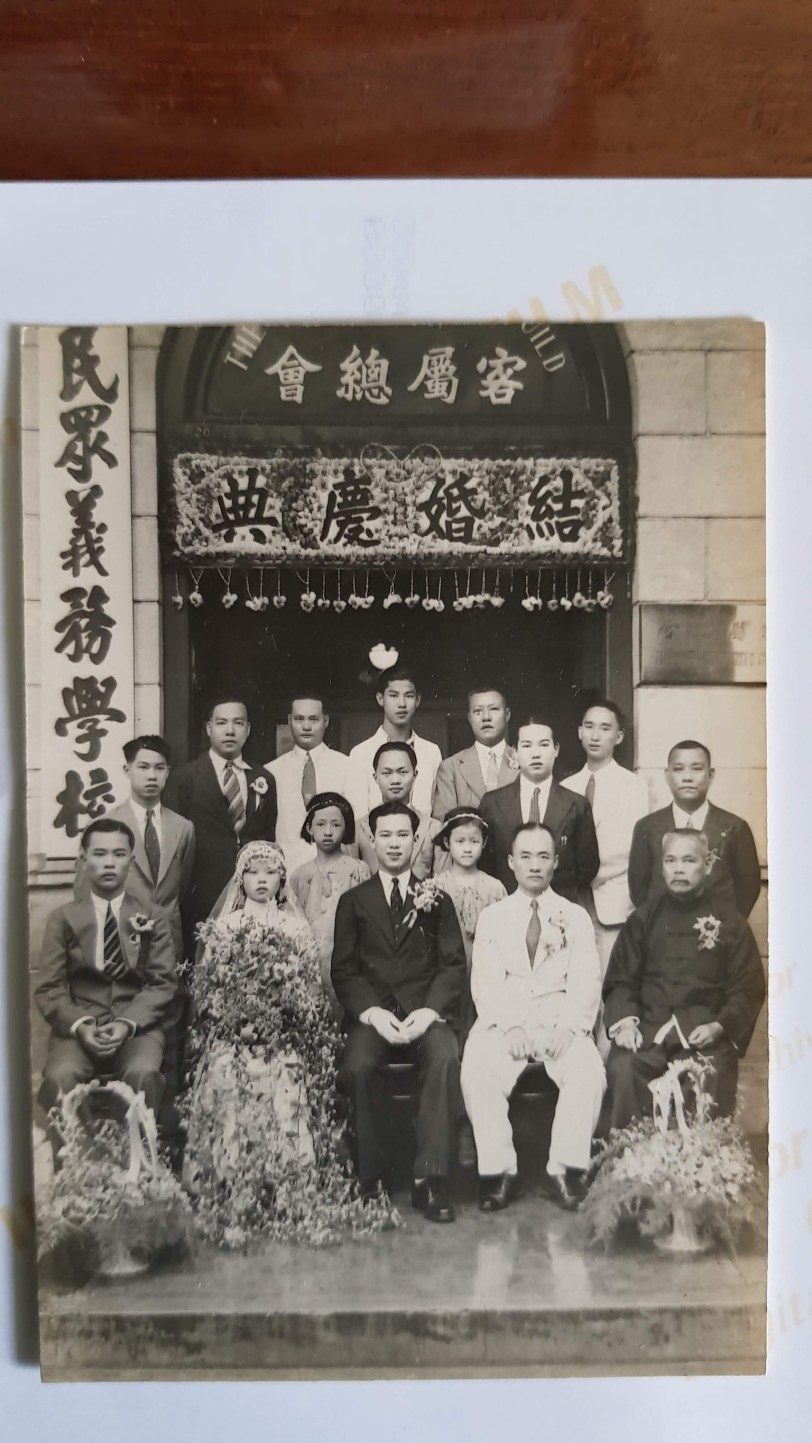
The wedding of Mr and Mrs Lam Joon Chong (Gen 24) at the Nanyang Khek (Hakka) Association in 1936. Lam Sen Tong (Gen 23) is at front row extreme right. (Lam Pin Swee Collection.)
Wow, I could now link my heritage back to 25 direct lineal ancestors, to the very first Lam who entered Dabu County! Excitedly, I searched backwards, to the 23rd Generation, 22nd, 21st until I had traced my tree up to our founding ancestor, Da Xing Gong himself. In the Song Dynasty (960-1279)!
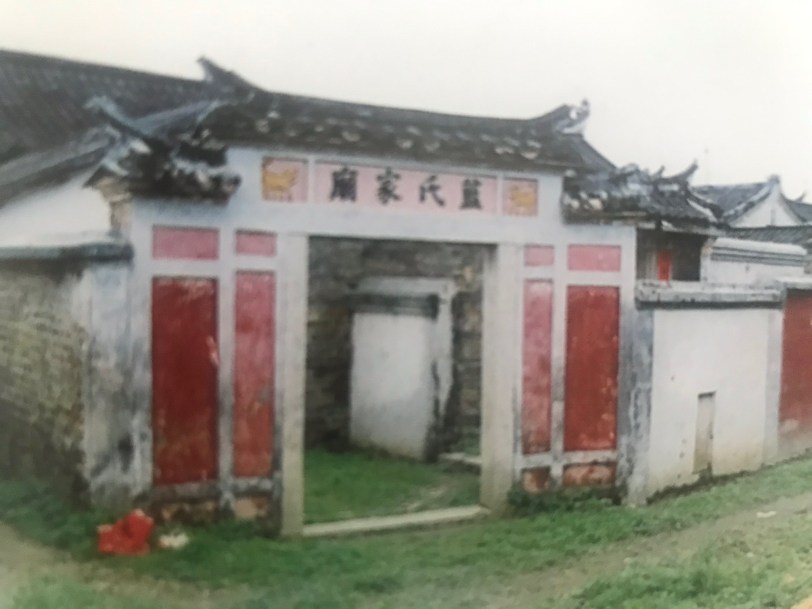
The family temple of the Xi An Gong (Gen 13) sub branch of the Junior Wing Fifth Branch — the sub branch that the Author belongs to. (From DLG)
And then, a thought struck me. Unlikely as it seemed, could my father’s name also be in these tomes? Unlikely, because of the fact that five generations of my family had lived in Singapore. Lam Chiew San, my great grandfather, came in 1865 (when Singapore had 35,000 people). My grandfather, Lam Joon Chong was the first generation born in Singapore in 1918. My father, Lam Pin Foo, born in Singapore in 1937 was therefore, I thought, unlikely to be in the DLG.
Nevertheless, I pored through Generation 25.
秉湖。
Pin Foo. Wow!
My next thought – maybe I should now turn to generation number 26?
With mounting trepidation, I flipped, and found the page.
智聪,智超,智明。
Chih Tsung, Chih Chao, Chih Ming. Me, and my two younger brothers were in!
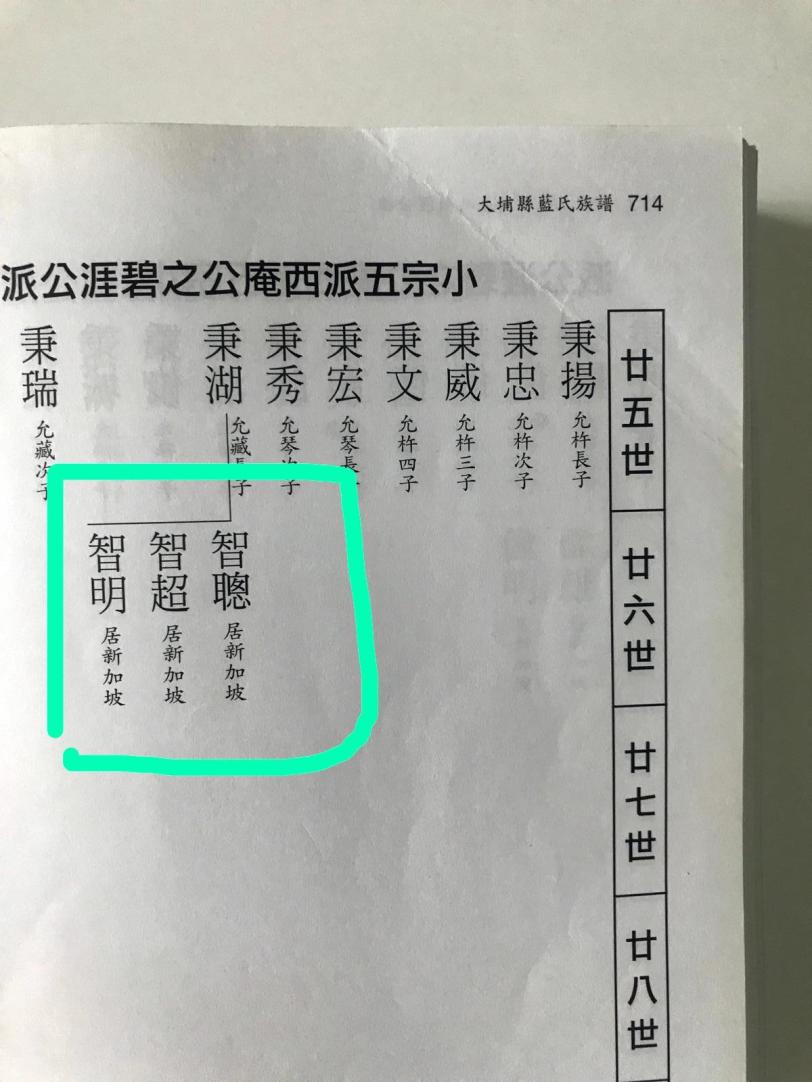
Eureka!!
But not my younger cousins Chih Chuan and Chih Bing (yes, the golfer). My youngest brother, Chih Ming, born 1970, was the youngest person in our grandfather’s line to “make it” into the DLG. On page 714 of Volume 7.
The DLG now provided me with knowledge of every single ancestor leading up to Lam Da Xing, as follows :
| Generation
Number |
Name
(Note 4) |
Year of Birth
till Year of death |
Chinese dynasty
during his lifetime |
Born during
this emperor’s reign |
| 1st | Da Xing 大兴 | Song? | ||
| 2nd | Mian Qi 勉齐 | Song? | ||
| 3rd | Gong 恭 | Song? | ||
| 4th | San Wu 三五 | Yuan? | ||
| 5th | Si Shi 四十 | Yuan | ||
| 6th | Wu Shi 五十 | Yuan | ||
| 7th | Xiu Shan 秀山 | 1326-1392 | Yuan-Ming | Tai Ding 泰定 |
| 8th | Jun Yi 均义 | Ming | ||
| 9th | De Bao 德宝 | Ming | ||
| 10th | Qing You 庆佑 | Ming | ||
| 11th | Yan Fu 彥富 | 1433-1500 | Ming | Xuan De 宣德 |
| 12th | Ming Jian 明鑑 | 1466-1545 | Ming | Tian Shun 天顺 |
| 13th | Ting Lian 廷璉 | 1491-1559 | Ming | Hong Zhi弘治 |
| 14th | Qiao 乔 | 1553-1634 | Ming | Jia Jing嘉靖 |
| 15th | Wen Pei 文珮 | 1593-1649 | Ming-Qing | Wan Li 万历 |
| 16th | Peng 蓬 | 1622-1669 | Ming-Qing | Tian Qi 天启 |
| 17th | Yuan Zhang 元騿 | 1667-1748 | Qing | Kang Xi 康熙 |
| 18th | Ying Jin 应锦 | 1714-1790 | Qing | Kang Xi 康熙 |
| 19th | Deng Ying 登灜 | 1746-1824 | Qing | Qian Long乾隆 |
| 20th | Yun Cang 運沧 | 1780-1851 | Qing | Qian Long乾隆 |
| 21st | Xin Zhao 新照 | 1800-1861 | Qing | Jia Qing嘉庆 |
| 22nd | Chiew San 秋山 | 1843-1930 | Qing-ROC (S’pore) | Dao Guang道光 |
| 23rd | Sen Tong 森堂 | 1872-1950 | Qing-PRC (S’pore) | Tong Zhi同治 |
| 24th | Joon Chong 允藏 | 1918-1997 | ROC-PRC (S’pore) | NA |
| 25th | Pin Foo 秉湖 | 1937- | ROC- (S’pore) | NA |
| 26th | Chih Tsung 智聪 | 1963- | PRC-(Note 5) (S’pore) | NA |
And what a tale the DLG tells.
The story begins patchily, but grows in specificity and color.
For the first six generations of Dabu Lams, there are only names and no dates. Until the seventh generation, there is only a single male Lam recorded each generation (Note 2) .
We are, however, talking of really early times, for the first three Lams probably lived during the Song Dynasty (960-1279) and the next three during the Yuan Dynasty. (1271-1368). Part of the reason for the slow population growth may be that times were tough during the end of the Song and throughout the Yuan Dynasty. Lam Hai Wen (the DLG’s editor in chief) also pointed out an interesting fact in his introduction, which corroborates the Yuan Dynasty thesis for generations 4-6. They had very strange names, as their names were numerals. San Wu (三五), Si Shi (四十) and Wu Shi (五十)literally mean thirty five, forty and fifty. According to Haiwen, who has a PhD in Chinese Literature, the Mongol rulers during the Yuan required ordinary Han Chinese to name themselves according to numerals.
It is perhaps no coincidence that the proliferation of the Dabu Lams began with the dawn of the Ming Dynasty. The seventh generation records two sons, Gui Shan and Xiu Shan, who as earlier described started the senior and junior wings of the Dabu Lam Clan. They had four and three sons respectively, who then marked the beginning of the Seven Branches around which the DLG is organised. Beginning with this period, many of the ancestors have graves which are identifiable to this day, providing another layer of historical proof.
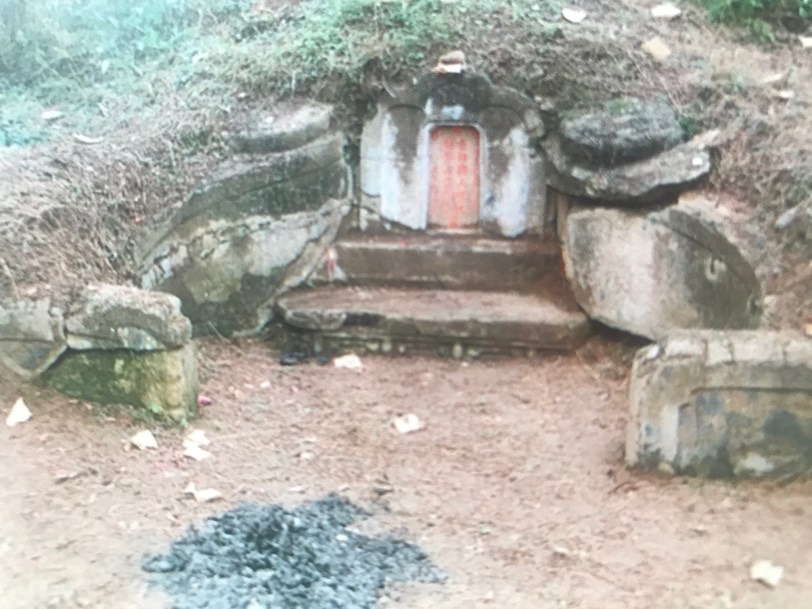
Ming Dynasty Tomb of Ming Jian Gong (1466-1545) (From DLG)
With the notable exception of the seventh generation, from the first to the tenth generation, there is no date of birth and death information. However, there is nevertheless greater specificity from generation seven onwards, at least in terms of the number and names of wives and sons recorded each generation.
Beginning with generation eleven, every generation has a clear birth date and death date. This has probably a lot to do with the fact that the first edition of the DLG was a project of the thirteenth generation, and there was a limit to how far back they could remember the birth and death dates of generations before their grandfathers.
From a broader perspective, the Dabu Lams were not the only ones beginning to write their genealogies in the mid sixteenth century. Far from it. Historians (Note 6) write that during this period, particularly during the reign of Ming Emperor Jia Jing (1521-1561, during whose reign DLG was first compiled), there was a concerted push among reasonably well to do families in Southern China to write their genealogies, with official encouragement. The lineage was not only for social and emotive purposes, it also served as an important legal and political entity, helping to establish and regulate land ownership and settle disputes within defined geographic areas. It was also an important entity that the imperial state interacted with, and relied on, as it increased its penetration of Southern Chinese society.
Another important development in the DLG, at least as far as my specific Xi An Gong sub branch was concerned, took place from Generation 15 onwards. The individuals in these generations began to have biographical highlights. The genealogy was thus no longer merely a record of their dates of birth and death, who their parents, wives and children were, and where they were buried. There were now brief descriptions of their lives. Perhaps it is not a coincidence that from generation 15 onwards, these generations lived (at least partially) in the Qing dynasty.
Thus, one of the most vividly sketched Dabu Lam is my 16th Generation ancestor, Lam Peng (蓝蓬1622-1669) (Note 7). Peng Gong (In Chinese, we use “Gong” as an honorific to refer to our ancestors) was a man whose martial talents made him a man for his times, for the Ming Dynasty (1368-1644) was coming to an end. Peng Gong had no desire to continue his father’s business. Instead, he revelled in practicing riding, archery and other martial arts, and in these endeavours, he had no rival in the village. He entered history when recruited by the famous General Wu Liu Qi (吴六奇), a colourful figure who was once a beggar and became a military man upon being talent spotted by a Ming general. Peng Gong helped with regional defences, and was recommended by Wu for a rank equivalent to today’s Colonel.
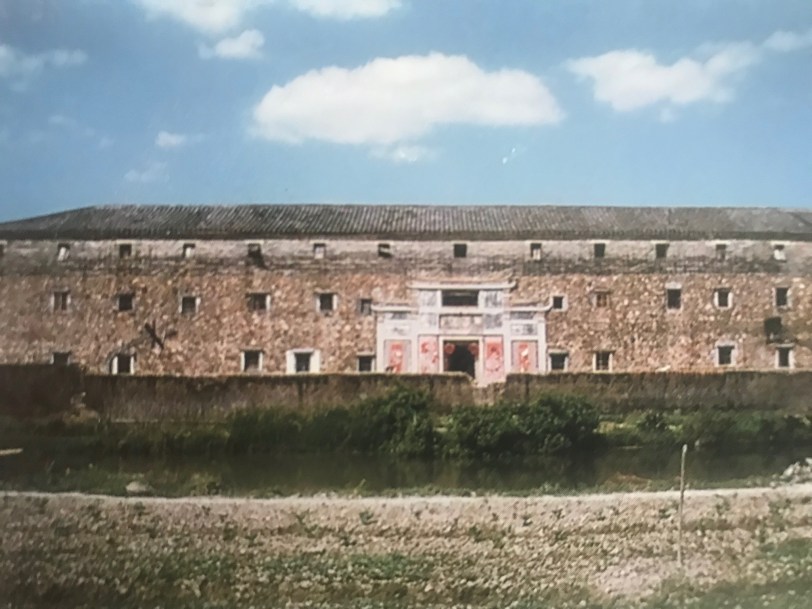
One of the most impressive Tulous (fortified communal housing) in Hakka Country, Tai An Lou (泰安楼). It was built by and housed a branch of the Dabu Lam family.
The other notable thing about Peng Gong was that he had ten wives and concubines, thirteen sons and eight daughters. This fact was directly relevant to the story of how my seventeenth generation ancestor (and Peng Gong’s son) Lam Yuan Zhang (蓝元騿 1667-1748)founded Gao Dao, the village my ancestors left to settle in Singapore.
Peng Gong died young at 48. At that time, Yuan Zhang Gong was only three years old. As his mother was the ninth concubine, and he himself so young, he was in no position to negotiate with his siblings for his property rights. Mother and son ended up with little, and went to live with mother’s own parents. When Yuan Zhang Gong grew up, being landless, he decided to set out from the long settled ancestral village of Xia Li, to a location 20 li away. There he cleared the land, and founded Gao Dao.
I visited Gao Dao in 2013. To put things in context, Dabu itself is a pretty remote, mountainous region. (After all, the County bills itself the “Shangrila of the Hakka World”.) Gao Dao, to use a Singapore expression, is just about the most “ulu” place in a very “ulu” province. Its very name speaks of its remoteness. For Gao Dao literally means “high path”.
When I was in Gao Dao, I was awed by how stunningly beautiful the mountain scenery was. I also noted how thin its mountain soil must be. Thus, Yuan Zhang Gong’s decision to leave Xia Li must ultimately have helped set in train the decision of his great great great grandson, Chiew San Gong (ie my great great grandfather) to leave the backbreaking life of a farmer in Gao Dao, and seek his fortunes in Nanyang.
Before coming to the pivotal Chiew San Gong, however, we should dwell on the life of my most colourfully described ancestor, Lam Deng Ying (蓝登灜 , 1746-1824). My 19th generation ancestor’s achievements were not particularly notable. His elder brother had some success at the government examinations and was appointed mayor of a neighbouring town. Deng Ying Gong served as his head of logistics.
What was more interesting were some anecdotes about Deng Ying Gong. The DLG records that he was born when his father was old and somewhat cranky. Deng Ying Gong’s father gave him the demeaning nickname of “Slaveboy”. It was said that tigers and ghosts were afraid of Slaveboy.
Once when their neighbour Mr Wu fell into the water, two ghosts pulled him down. However, when they saw my ancestor approaching, one of the ghosts exclaimed, “Slaveboy is coming!”, and hastily let Mr Wu go. Thus was Mr Wu saved from drowning.
At the spot where this happened, Deng Ying Gong erected a Buddhist stele, to prevent the ghosts from reappearing.
On another occasion, Deng Ying Gong approached what he thought was an ox, and kept walking towards it. The ox slouched away. Only the next day when he heard that Mr Ho’s dog had been eaten by a tiger in the vicinity, and the tiger’s tracks led to the spot where the “ox” had been, did Deng Ying Gong realise that he had walked close to a tiger, and the tiger had walked away from him! Thus, even the tiger was afraid of Slaveboy!
These anecdotes are distinctive because their frank, gossipy tone is so out of character compared with the rest of the DLG, which tends (as you would expect) to be solicitous and respectful in its tone about ancestors. The story about ghosts is recounted in a matter of fact manner, taking for granted that nobody doubt ghosts exist, speaking to the different worldview of 18th century China. The tiger anecdote is also eye catching, giving a taste of agrarian life up in the mountains.

Lam Chiew San (Gen 22, 1843-1930), founder of the Dabu Lam Clan in Singapore. He started Singapore’s first pawnshop. (Lam Pin Swee collection.)
I began this blog post with the story of Lam Chiew San (1843-1930), my Gen 22 ancestor, kneeling before his mother for three days, because she was highly reluctant to let him sail to Nanyang. Why was she so reluctant? The DLG records that this was the age of sail, and more died than lived enroute to Nanyang. But Chiew San Gong saw the meagre farming lives of his elder brothers, and decided to take the risk. The Qing court’s ban on overseas ocean travel had recently been lifted, creating opportunities for the ambitious. Chiew San Gong set sail from the Fujian coast, and after forty days, arrived in “Selat” (唶叻, one of the then name for Singapore). Working his way up from his initial job as a common labourer, he founded Singapore’s first pawnshop in 1872 and then three more. He became the Chief Executive of the Char Yong Association, the Dabu Clan Association.

Lam Sen Tong (Gen23, 1872-1950), Singapore’s biggest pawnbroker during the interwar years. (Lam Pin Swee collection.)
His son Lam Sen Tong (1872-1950) built on Chiew San Gong’s early achievements to build what was then Singapore’s largest chain of pawnshops. He was also one of the prime movers for setting up Kee Fatt School, a school for the Hakka community, and was its single biggest benefactor. He likewise contributed to various schools in China and to clan association activities in Singapore and Malaya. He was one of the wealthiest Hakkas in the pre War era (though the Hakkas were quite behind the Hokkien titans). Like many self made Chinese of his era, he dreamt of returning to his ancestral land in glory. He built a hundred room mansion upon his return to Huliao, Dabu, a courtyard style house with interesting sino-western fusion architecture we were fortunate to visit during our 2013 trip, and now designated a provincial heritage site.

The House that Lam Built. Lam Sen Tong’s 100 room mansion, in Huliao Dabu. Ironically, photo is taken in 1949, just as the Red Army is about to put an end to this way of life. As of 2013, it had been converted into a Communist Party Training School. (Lam Pin Swee Collection.)
I can go on and on about the DLG (as my friends who have had the misfortune to ask me about it know.) I can tell about how the DLG claims to connect Da Xing Gong to earlier genealogies of Lams from Fujian province, which in turn connect with even earlier Lam genealogies, purporting to connecting my 26 generation lineage up the chain a further 129 generations! I can provide you my findings from scouring the internet, about my views on when historicity ends and fable begins. (After all, the earliest generation of the Lams in all China is stated as beginning in 2732BC, before the first historically recorded Shang dynasty, with the first Lam purportedly an approximate contemporary of the legendary Chinese emperor Huang Di!) I can tell the story of how these 129 generations started in North China, migrated southwards to Nanjing, before coming to Jiangxi, Fujian and finally Dabu in Guangdong. We can have a long conversation about the history of the Hakkas, the “guest people” of China, and theories about their five waves of migration.
I can also explore other fascinating things I learnt from my researches on the DLG. Like how in dynastic times, each Chinese person used to have up to five different names, their ming(名),zi (字),hao (号),hui (讳),yi (謚), given in different periods of their lives, and used by different persons to address them, for different purposes in line with different notions of ritual curtesy. From there, we can have another long conversation on how the ancient Chinese worldview differs from ours today.
Or I can talk about how laborious it was to come up with the birth and death dates in the table of my 25 lineal ancestors, given how different the old Chinese Calendar is from the modern Gregorian version. How I learnt to read the ancient Chinese sexagenary cycles (60 year cycles) comprising combinations of heavenly stems (10 in total) and earthly branches (12 in total). How these, together with knowing which emperor (in which dynasty) reigned then, would reveal to you your ancestor’s year of birth. How, for instance, 明正德庚午 is the year during the reign of Ming Dynasty(明) Emperor Zheng De (正德), where the heavenly stem is geng (庚) and the earthly branch is wu (午)。From which you have all the information you need to figure out it is really 1511 CE!
One’s ancestral genealogy is a fascinating locus for understanding one’s own culture. It’s a conduit for understanding how people who gave you their genes, lived their lives and faced up to the trials they encountered. It gives perspective on our own challenges. What would Chiew San Gong have done in this situation, I now sometimes ask myself.
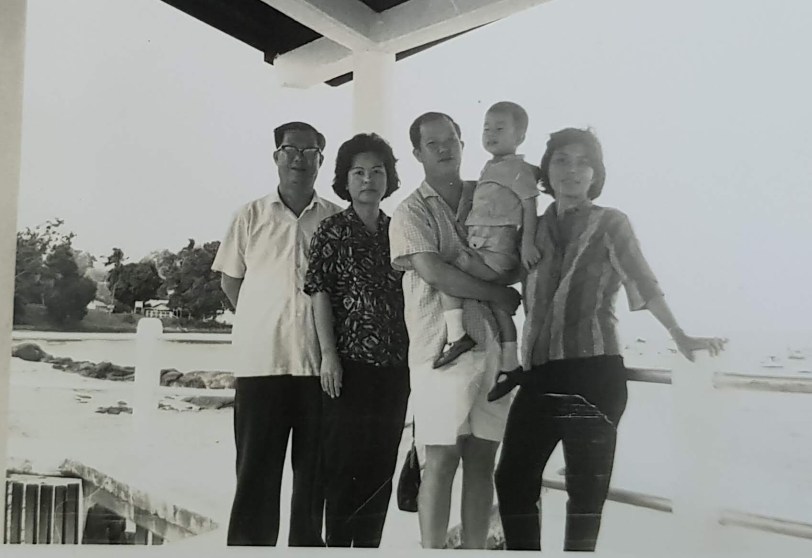
Dabu Lams — Gens 24, 25, 26 (male and female!), relaxing at Changi. The author fondly recalls those beach holidays! (Lam Pin Swee Collection.)
Ultimately, “Who am I?” is tied to “Where do I come from?” Having found these books, I am one of the fortunate ones. Where once there was darkness, now there is light. Turning around and looking forward, the path is clearer. History is not just about glamorous monarchs. It is most potent when it is a past you can call your own.
About the Writer
Lam Chih Tsung is the eldest son of your humble blogger. He is the Founder of Axiom Asia Private Capital, a private equity fund of funds. Prior to starting Axiom, he was Executive Vice President at the private equity arm of the Government of Singapore Investment Corporation. He attended the Chinese High School and Hwa Chong Junior College. As a result of his unworldly passions at age eighteen, he ended up reading Philosophy at Cambridge University. Today, he is interested in balancing his youthful fascination for Nietzsche and Wittgenstein, with a deeper understanding of the civilisation he is born into.
Footnotes
Note 1 : Nanyang, literally Southern Ocean, Chinese reference to Southeast Asia
Note 2 : Excluding a few who left the county, hence deemed to fall outside the DLG’s remit.
Note 3 : Gong (公)-Honorific to denote one’s elder male relative of one’s grandparents’ generation and above.
Note 4 : All Ancestor names written in the Latin alphabet are per Hanyu Pinyin, except from Gen 22nd onwards.
Note 5 : Even though the last five generations of the Lam family has lived in Singapore, I follow the convention of the DLG and show the Chinese dynasty/regime which correspond to the period they are living. For instance, even though I am a Singapore citizen, I show the Chinese dynasty/regime during my lifetime as the PRC. This is not meant to suggest citizenship or political affiliation !
Note 6 : See for instance Emperor and Ancestor : State and Lineage in South China, David Faure; Also, 嘉靖祭祀礼制改革在客家地区的宗族实践: 《大埔县蓝氏族谱》的解读,宋德剑,谭兆风,嘉应学院客家研究所。
Note 7 : I would like to thank my former classmate Lee Ching Yan for helping me translate from classical Chinese to modern Chinese three passages in the DLG (on Lam Peng, Lam Deng Ying and Lam Yun Cang). The classical Chinese used in these particular passages was harder for me to comprehend. Ching Yan’s command of classical Chinese was one of the best in my Chinese High class.
Bibliography
1. Dabu County Lam Clan Genealogical Tables, 10th Edition, Editor in Chief Lam Hai Wen (十修大埔县蓝氏族谱, 蓝海文博士主编)
2. Emperor and Ancestor : State and Lineage in South China, David Faure, Stanford University Press
3. 嘉靖祭祀礼制改革在客家地区的宗族实践: 《大埔县蓝氏族谱》的解读,宋德剑,谭兆风,嘉应学院客家研究所
Excellent findings! I am really impressed and awestruck, at least now I know where the Lam family descended from and tracing all the way back to 130 generations to the first emperor is really excellent indeed! Thanks so much!
Tsung to reply
>
Thanks.
I am just starting on my journey to discover my family history and engaged My China Roots. They called up the Hakka associations in Singapore and found my grandfather’s name (Lam Khoy Kon) at Char Young Association. They confirmed that he was from Dabu and our ancestral village is Gaodao village, which you also mentioned in your article.
Thank you. Your article helps me understand my past as I try to piece things together. I shared your article with My China Roots, asking them why if we are of the same ancestral village, your generation names do not look familiar to me. Their reply: “It’s very common that there are different lines in the same clan. Though they originated from the same place, the descendants started their own lineages and created a new generation poem to distinguish them from the others.”
Did you end up visiting Gaodao? There is so little information about it.
Kenneth Lam Chien Wai
Hello Kenneth,
Thank you for this comment and also your friend request on FB.
Yes, I have been to Gaodao.
Good luck on your search. If you would like to forward me the name in Chinese characters of your various ancestors, together with approximate years of birth and death, I can take a look in the DLG to see if I can find any of them.
If you prefer, you can also messenger me on fb messenger.
Chih Tsung
Wish I can mixed around and brush up on my hakka
Good for you.
Hi Pin Foo,
I am Lam Meng Choo, wife of Lam Pin Kuen ( 3rd brother of Lam Pin Kee, who runs the Wing Teck Pawnshop in Serangoon, previously at Middle Road).
I read with great interest and pride on yours and Chih Tsung’s research on the DLG. It was a great piece of research and masterpiece to keep the DLG alive. Your sharings on the Lam’s historic past and achievements will inspire the younger generations to strife and do their very best to fulfil their future dreams.
I always wonder what is the “middle name “ after Pin 秉. I noted that your son’s middle name is Chih (智) whereas Pin Kuen/Kee ‘s children middle name is Zhao (兆)which we were told is the next generation’s middle name .
Good if you can share with me your knowledge on this. Good for the future generations to continue with this Lam lineage by their specific middle name .
Looking forward to hear from you and let’s hope someone in the Lam Clan can continue to uphold this great Lam Clam lineage and DLG .
Thank you and warmest regards from Meng Choo
Dear Auntie Meng Choo,
In the case of our zhupu, there is no prescribed middle names. As such, the selection of the middle names is chosen by individual parents, whose siblings might in term follow them, thus giving wider distribution to such middle names.
Thank you.
Chih Tsung
Dear Chih Tsung,
So nice to hear from you and if I may call you my “new found nephew” , thank you for your explanation. Now I understand better.
Very happy to receive your dad ‘s call today and I felt great to reconnect with my husband’s close blood relatives. Like what you said that” “having found those books, I am one of the fortunate ones”, I must also say that I am one of the fortunate ones to read your masterpiece and now am fully aware of the Lam’s Clan heritage and achievements.
Thank you and have a good and blessed weekend ahead with your family.
Meng Choo
I know so little of my Lam I only know I a Dapu kak, there’s so much I am missing
I didn’t think I would read to the end – you know how much of a bear of little brain i am in general, but i have as it was fascinating and your narrative spell binding.
Thank you Gek. Glad it passes muster with professional instructors of English at NUS!
Tsung
Hi Tsung
Well done! This is such a well researched piece of work about our Lam ancestral history. It is indeed a great achievement to have gone through such tedious hard work to complete this wonderful article.
I have been to most of the places ( in Dapu) you have mentioned, but your clear explanation of their background and history has provided so much more clarity. Fantastic work Tsung👍👍👍👍
Aunt Kim Lian
Thank you Tai Koo, for your kind comments.
Tsung
Hi Chih Tsung
Very interesting piece!!
I forwarded its link to friends. They were fascinated and some are considering searching their own Chinese roots. I did a bit of googling and found this website, ‘My China Roots’. For people, who have no stamina or are not inclined to do the seriously hard work you did to research into and beyond the DLG, this may be a short-cut?? At a price, of course!
Lim Toke Feng
Francis Seow Tai Kong’s wife.
Hi Auntie Toke Feng,
thank you for your kind words and I also enjoyed your piece on Orchids on lampinfoo.com too!
I took a quick look at “My China Roots”, and prima facie, it does look like they have a good collection of people. They may be a good way to proceed, but that is just based on a quick review.
I would however probe them on how they are able to utilise Southeast Asian and particularly Singapore leads. Do their team have people based in Singapore? I couldn’t establish that.
There could be many leads at the Singapore end as well. Your friends would be advised to contact their relevant clan associations as a first stop. The Clan associations might be able to offer leads and possibly (if you are very lucky) even the Genealogical tables.
At the China end, I personally found DIY to be a viable option for myself. For instance, for my Mother’s paternal Oon family, initially, I knew only the name of the village. I managed to locate it through Baidu (but only after some difficulty as the county that the village belonged to during Qing times (and for which family memory persisted) had been changed from Zhangzhou to metropolitan Xiamen, as it is now during the PRC period. Once the village is located, the key thing is to head to the family temple. There may well be a knowledgeable custodian there who can provide leads, or provide even a genealogical table in some cases.
In my mum’s Oon family case, we were incredibly lucky because the Oon family temple custodian we met turned out to be a true repository of family lore.
So if one is unwilling to pay but want to proceed, going to the clan association in Singapore, “baiduing” one’s village location and then going to the family clan temple once one arrives in the actual village once there will be the de riguer steps, in my view.
Obviously, it will matter greatly if your friends can read Chinese, and also traditional Chinese characters (繁体字)as opposed to simplified characters (简体字)as is taught in our school today. If they can’t, then something like “My Chinese Roots” would be clearly the best path.
There are also fantastic online sources in Singapore, that shouldn’t be ignored. For instance, did you know that a lot of Singapore’s oral history archives are digitised and can be accessed online. Thus, if you were to go onto the national archives site right now, and type in “Lam Joon Chong”, my grandfather, and Uncle Francis’ uncle, you will discover that there are 26 oral history transcripts that he gave! The National Archives were interested in him, presumably, to tell them the early history of the pawnshop industry and the hakka community. You can listen to LJC, or you can read his transcripts in Mandarin. Isn’t that neat? I stumbled on this one day when I decided simply to type in “Lam Joon Chong” and see what happens!
If your friend have a serious interest, I don’t mind having a call with them to discuss with them a plan, for what its worth. We can discuss offline. I find other people’s genealogy also quite interesting!
Chih Tsung
Chih Tsung and Pin Foo, – a most interesting piece of detective work. I was wondering how Chih Tsung and his siblings’ names were included in the genealogy records. Who reported their births back to the clan in China, not Pin Foo I’m sure.
Dear Chan See,
My late father did.
Cheers Pin Foo
>
Hello Uncle Chan See,
just to add to my dad’s response, I tracked down the editor in chief, Mr Lam Hai Wen, who lives in Hong Kong. I had dinner with him while there. I also posed the question of how he got the info on my name, just to do my own fact checking. He replied that he had a whole team of investigators who tracked down different branches of the Lam family, in the PRC and also overseas. The genealogical table project was backed by a steering committee that included donors. (I note that a close female relative of Stanley Ho, the Macau casino magnate was a Lam and was (I suspect) the biggest contributor to this project.)
It probably helped that my grandfather, Lam Joon Chong was the founding president of the Singapore Lam Clan Association, and his nephew and my uncle, Lam Pin Khee was a subsequent long time President as well. (In fact, LPK is mentioned as a member of some advisory committee for the 10th edition genealogy project in the DLG itself. As both LJC and LPK made frequent trips to Dabu, one can imagine them maintaining the necessary contacts for our names to be included.
Interestingly, when I met up with Lam Hai Wen, the editor, we established that we were actually relatively close relatives, both coming from Gao Dao village. He and I were of the 26th generation (even though he was about 20 years older), and shared the same ancestor a “mere” 6 generations back. So he would also be particularly attuned to the needs of memorialising fellow Gao Dao village descendants!
Chih Tsung